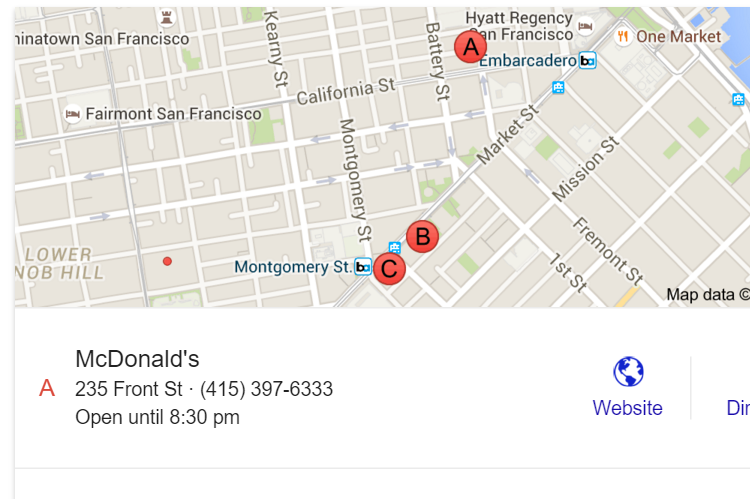by Zipbooks Admin
Can you delete Google reviews?

Business owners know that their reputation today is built from online feedback—and customers know this too. Sometimes this means that vindictive exes or jealous competitors will try to troll your company by writing fake reviews for your GMB listing. But, there’s no need to fear—it’s possible to delete Google reviews.
Platforms like Yelp or Facebook used to be the go-to places for customer feedback, but Google has surpassed them in value. Currently, there are about 71,000 searches performed on Google—per second!
If your business doesn’t have a Google My Business (GMB) listing and at least a dozen online reviews, it’s like you don’t exist.
What’s unique about Google is that all search queries are interpreted as local. That means, even if you just type in “best mexican food,” Google will show you the results that are closest to you in location. This means that for small businesses like restaurants, clothing boutiques and hair salons, your GMB listing (including reviews) will show up first for nearby searchers.
If you want those nearby people to walk through your doors, your review profile needs to be pristine. That means keeping a high star-rating, getting reviewed regularly and following Google’s guidelines
Google’s Content Guidelines
“Where contributions distort truth, we will remove content.“
Google’s mission is to provide user content that is as authentic and helpful as possible. After all, if they don’t provide the best information at the top of their search results, they are failing their users and run the risk of losing business.
Google has specific content guidelines in relation to any content shared by users, including reviews. If a review violates any of these guidelines, you can likely get it removed:
- Spam and fake content: Content must reflect genuine, first-person experiences
- Off-topic: Must not contain general, political or social commentary or personal rants
- Conflict of Interest: Business owners, current or former employers and competitors should not submit reviews
- Impersonation: Deceptive content and false representations are not allowed
- Other restrictions: Anything that is illegal, sexually explicit, profane, derogatory, hateful, salesy, etc.
Spotting Guideline Violations
Just because a review says mean things about you, doesn’t mean you can delete it. However, if the review violates any of these guidelines, you can—and should—get it removed.
For example, consider the text of these one-star reviews of a local burger shop:
- The restaurant was clean and modern-looking, but the food was cheap and service was terrible. It took more than 30 minutes to get my order and I was the only one in there. The burger was cold by the time it got to me and the fries were really greasy. I had heard good things about this place. It’s too bad.
- My brother ate here and said the food is gross. There are much better burger places nearby, like StarBurgers. I don’t think this place even serves vegan burgers, they probably condone animal cruelty. I would give this place half a star if I could. Bad company. Bad people.
While Review #1 does reflect poorly on the restaurant, there’s nothing really that violates Google’s guidelines. You should look into the review, verify the timing and the order, but if it checks out, you can’t delete it.
Instead, see if there were any specific reasons for the bad experience (maybe the fry cook was still training or your team was short-staffed that day). Then, explain the circumstances and offer a refund.
On the other hand, you might be able to delete Review #2. The experience is not firsthand, (“my brother”) thus falls under “Spam”. The reviewer is vague and advocating for a competitor— “Conflict of Interest”. The comments about animal cruelty fall under “Off-topic” violations. Even if you couldn’t prove that this review was fake, you could get it removed for violating Google’s guidelines.
Spotting Fake Google Reviews
Aside from policy violations, there are a few other telltale signs of fakes:
- Details are weirdly vague
- Tons of spelling errors
- References employees who don’t work at your company
- Buyer name isn’t in POS payment history
- Purchased item and transaction date don’t match
- Surge of bad reviews in short time period
- Connection between reviewer and competitor
- Repeated word-for-word phrases
- Reviewer has posted in multiple geographic locations
- Lack of qualifiers (e.g. the cafe was clean at least, but the food was terrible…)
There are also websites like Fakespot and ReviewMeta that help to determine whether or not reviews are trustworthy. These sites use AI to analyze fraudulent feedback and find patterns in the data.
How to delete Google reviews
You can’t just delete reviews you don’t like, but there are ways to get rid of the fakes and irrelevants.
Before you go on the offensive, be sure you’ve got proper evidence. When you do get in touch with someone, you’ll need be able to prove that the review is fake or that it violates Google’s policies. Have screenshots ready, data from your POS, relevant links or details and specific examples of guidelines violations.
And know that even if you’ve made a killer case, it may take some time for Google to actually get the review removed. Just do all that you can and be patient.
Here are 5 ways to delete Google reviews. Each method only takes a minute or two, so there’s no harm in trying all of them.
1. Flag inappropriate reviews
If you have verified that the review violates specific Google guidelines, you can flag the review as inappropriate.
From Google Maps
- Find the review you’d like to delete
- Select the flag icon next to the star rating
- You will be sent to Google’s “Report a policy violation” page
- Enter your business email
- Select violation type
- This post contains hateful, violent, or inappropriate content
- This post contains advertising or spam
- Off-topic
- This post contains conflicts of interest
- Hit Submit
From your GMB Dashboard
- Open the location you’d like to manage
- Click “Reviews” from the side menu
- Find the review you’d like to delete
- Click the three vertical dots
- Then “Flag Review”
2. Contact Google Support
Flagging a review is just the first step. It’s a good idea to also reach out to Google’s support team in order to expedite the process.
From your GMB Dashboard:
- Select “support”
- Choose a method of contact
- Make your case (spare no detail)
- Add a screenshot of the review in question
You can request callback, chat or email support. Once a decision has been made, a Google associate will reach out via your requested method of contact.
3. Tweet @GoogleSmallBiz
Reach out on every platform to get those fake reviews removed ASAP. Request help from Google’s small business support account @GoogleSmallBiz.
On Twitter
- From your company account, tweet @GoogleSmallBiz
- Include the most important details
- They will likely reach out to you to DM
4. Post on Google’s Community Forum
Why not go all the way? Make your grievance known on Google’s Spam and Policy Forum as well.
This page has thousands of threads about fake reviews, keyword-stuffed business names, duplicate locations, wrong events and more. You can add your issue to the page to have it addressed by Google team members and community experts.
5. Visit Google’s Request Page
Google’s Troubleshooting page, “Removing Content From Google,” will walk you through the specific procedure for your product and situation.
If the review could be considered slander or libel, you can use this form to submit a Legal Removal Request.
Additionally, if you have obtained a court order against the reviewer, you can submit it to Google by filling out this form (though it’s unlikely you’ll go this far).
Reply to Every Customer
If you spot a fake review, immediately follow every method for removal. Once you’ve done that, take a minute to respond to the feedback.
Wait, isn’t the whole point to get the review deleted? Why acknowledge a fake review with a response?
Ignoring bad reviews (even fake ones), makes it looks like you don’t care what customers think. In fact, customers are starting to expect interaction from businesses, especially if the review they left was negative.
Treat the review as if it was real and respond in genuine. You do want to pacify unhappy customers, but you also want to win over anyone who reads your response—show prospects that you take feedback seriously.
78% of online reviewers said that they actually trusted a business more when they saw them respond to online reviews, so make the time to say thank you and resolve problems.
Remember, it may take a while for the review to be removed, so it’s better to respond in kindness than to let anger fester.
How to Respond to Negative or Fake Reviews
Whether the review is real or fake, mean words can hurt. Don’t react emotionally. Take the time to cool off so that you can be diplomatic in your response.
Say I’m sorry and offer reparation or explanation when needed. Keep your public comments brief and invite the reviewer to continue the conversation in private.
If you are certain that the review is fake, it’s okay to be a little more vague in your reply. Acknowledge that you have checked your POS system or other records and find no evidence of the interaction. Note that your inability to verify the situation is inhibiting your from resolving the matter and providing a refund. Even though the review is fake, you need to sound genuine in your desire to help.
Here’s an example of how you could respond:
We are very disappointed to hear about your experience and are working to rectify the problem. Unfortunately, we have not been able to verify this situation. We have no record or recollection of any customer experience fitting this account. If you were a client of ours, we’d love to investigate this issue further so we can work towards earning back your business. Please reach out to us at ________ and we’ll remedy this ASAP.
There will be trolls and spammers who are cluttering up your GMB reviews, but there are also customers who sincerely want their voice to be heard. If you can listen to their pain points, and respond well, they may even change their review. Use the review platform to turn detractors into disciples.
Ask Customers to Update Comments
While you may not be able to delete google reviews, you can improve a bad review by fixing the problem and asking customers to update comments. Many customers who feel that their complaint has been addressed are willing to change their reviews. However, they probably won’t think to do it on their own.
If they shared feedback publicly on a review site or elsewhere, ask them to update their post to reflect how you worked to solve the problem.
One Harris survey stated that when companies responded to negative comments, 33% of complainers turned around and posted a positive review and 34% deleted the negative review themselves.
For your customer: How to edit or delete a review
This kind of follow-up can make a big difference for your company, but obviously, you can not edit review text for your customers. You can, however, guide them through the process.
From Google Maps
- Sign into your Google Account
- In the top left, click the three horizontal lines
- Click “Your Contributions,” then “Reviews”
- Next to the review you want to edit or delete, click the three dots
- Choose an option: “Edit Review” or “Delete review”
- Make any changes and submit
Negative Reviews can be Good for Business
While deleting fake Google reviews can be helpful to your business, you don’t need to panic every time you see a low-star rating. A few negative reviews can actually be good for business.
Customers know that no one is perfect. If customers see a total lack of negative reviews, they will presume that you are burying the negatives or buying fake positives. This lack of transparency will never reflect well on your business.
One Harvard study suggested that “under certain circumstances, even terrible publicity can bolster the bottom line.” While well-established companies should try to limit bad press, small businesses can actually increase awareness with a little negativity. The study suggests that in the case of unknown companies, product awareness can linger even after memory of the bad review fades.
That being said, if you keep getting negative reviews or similar comments, it’s not them—it’s you.
Take advantage of the qualitative data these individuals provide to your business. Listening to customer pain points will help you better serve them in the long run. Listen with an open mind and make the changes you need to.
The Best Defense is a Good Offense
By no means should you let spammers get the best of you. Keep an eye out for fake reviews and take action when needed.
An even more effective strategy is to build up lots of positive reviews from happy customers. ZipBooks can help you do just that—we’re all about growing your business.
Inviting and monitoring online reviews needs to be your new SEO and marketing priority. You have a great company and you deserve a great reputation!





